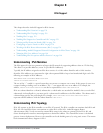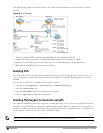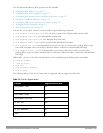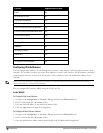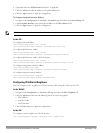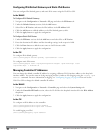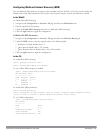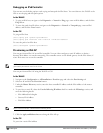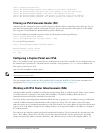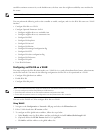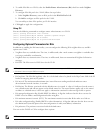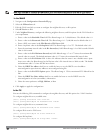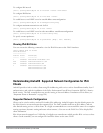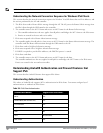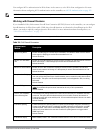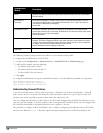
(host) (config)# provision-ap
(host) (AP provisioning)# master <IPv6 address of the master controller>
(host) (AP provisioning)# dns-server-ip6 <IPv6 address of the AP's DNS server>
(host) (AP provisioning)# ip6addr <the static IPv6 address of the AP>
(host) (AP provisioning)# ip6prefix <the prefix of the AP's static IPv6 address>
(host) (AP provisioning)# gateway6 <the default gateway IPv6 address for the AP>
Filtering an IPv6 Extension Header (EH)
ArubaOS firewall is enhanced to process the IPv6 Extension Header (EH) to enable IPv6 packet filtering. You can
now filter the incoming IPv6 packets based on the EH type. You can edit the packet filter options in the default
EH, using the CLI. By default, the default EH alias permits all EH types.
Execute the following commands to permit or deny the IPv6 packets matching an EH type:
(host) (config) #netexthdr default
(host) (config-exthdr) #eh <eh-type> permit | deny
To view the EH types denied:
(host) (config-exthdr) #show netexthdr default
Extended Header type(s) Denied
------------------------------
51, 234,
Configuring a Captive Portal over IPv6
IPv6 is now enabled on the captive portal for user authentication on the Dell controller. For user authentication use
the internal captive portal that is initiated from the controller. A new parameter captive has been added to the
IPv6 captive portal session ACL.
ipv6 user alias controller6 svc-https captive
NOTE: This release does not support external captive portal for IPv6. The captive portal authentication, customization of pages, and
other attributes are same as IPv4.
You can configure captive portal over IPv6 (similar to IPv4) using the WebUI or CLI. For more information on
configuration, see "Configuring Captive Portal in the Base Operating System" on page 234.
Working with IPv6 Router Advertisements (RAs)
ArubaOS enables the Dell controllers to send router advertisements (RA) in an IPv6 network. When a host connects
to an IPv6 network, it configures itself with a link local address. The link local address allows the host to
communicate between the nodes attached to the same link.
The IPv6 stateless autoconfiguration mechanism allows the host to generate its own addresses using a combination
of locally available information and information advertised by the routers. The host sends a router solicitation
multicast request for its configuration parameters in the IPv6 network. The source address of the Router Solicitation
request can be an IP address assigned to the sending interface, or an unspecified address if no address is assigned to
the sending interface.
The routers in the network respond with periodic unsolicited RA packets. The RA contains the network part of the
Layer 3 IPv6 address (IPv6 Prefix). The host uses the IPv6 prefix provided by the RA; generates the universally
unique host part of the address (interface identifier), and combines the two to derive the complete address. To
DellPowerConnectW-SeriesArubaOS6.2 | User Guide IPv6Support | 136



